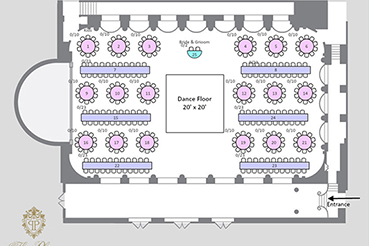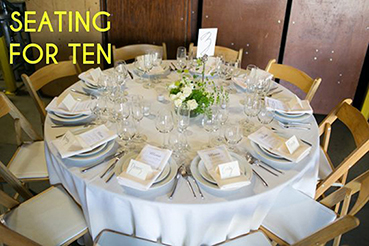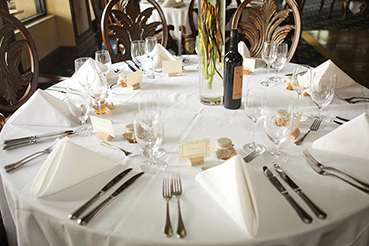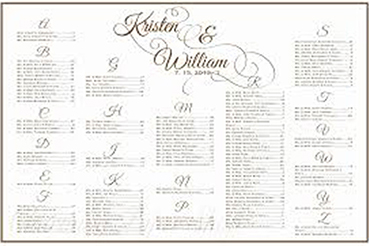Wedding Reception Seating Etiquette
Arranging family and friends at the reception can be tricky. Here's the rundown of where everyone should sit and how to get them to their seats.
Your parents are divorced, your last unattached friend is hypersensitive to being seated at the "singles" table and you have one couple coming in from out of the country who only know you and your partner. What to do? With a little tact, diplomacy and common sense, you can create a seating plan that will make everyone happy.
Why a Formal Seating Plan?
You may feel like developing a formal seating plan isn't really necessary, and that your guests are intuitive and go-with-the-flow enough to figure out where to sit. The logic: If you provide enough seats, can't everyone just figure it out on their own? The answer is: Yes... eventually. If you've ever been to a wedding without a seating plan before (and survived the riptide of guests trying to find their places, or seen the bottleneck after they've been through the buffet line trying to figure out where to sit), then you know why making one is a great idea. Taking the time to develop a plan will reduce your guests' anxiety of trying to find a seat (whether it's family and friend dynamics, not knowing if some tables should be reserved for VIPs, and not wanting to exclude anyone in a group or without a plus-one) and your involvement in mediating issues.
On the other hand, if you're having fewer than 50 guests, you may not need a detailed plan if you don't want one. You could also choose to designate the head tables (including you two, your wedding party and parents) with place cards, and allow the other guests to seat themselves. Some couples opt to have a cocktail party or buffet with a few tables, so guests can alternate sitting and eating. If this is what you plan to do, make sure your elderly guests have a place to sit down, possibly even by designating a separate table for them. But the bottom line is we always recommend having a seating chart—your guests don't want to make any mistakes and they simply like knowing that you thought of them and where to place them.
Who Sits Where?
Wedding Party Table
The newlyweds may sit at their very own sweetheart table. Some couples choose to have no table at all, but to leave a few seats empty at every table so they can mingle throughout the reception. No matter which configuration you choose, the wedding party table is usually set apart from the others by some type of decoration, like flowers.
Classically, the groom sits to the bride's right and the best man sits to her left. The maid of honor sits to the groom's right.
Family Tables
The parents of the couple often sit opposite each other at a large family table, with grandparents, the first degree relatives and other close friends. Another option is for the parents to head their own tables, with their family members and close friends. In the case of divorced parents, each parent may also host his or her own table, smoothly diffusing any awkwardness or discomfort.
Mix and Match
As for the rest of your guests, should you put friends together or seat them with people they haven't met? While it's may seem like a great idea to mix in a few new faces at each table (and totally okay to do so sparingly), remember that people are most comfortable when they know some of their dinner companions. Be considerate. Not even your most gregarious friends will want to sit at a table full of complete strangers, so put acquaintances together when you can. If you have guests who don't know anyone, seat them near guests with similar interests. If you have a group of friends that can't fit at one table, split them down the middle, and fill in each table with other guests. Whatever you do, don't leave one of the gang out.
If you have no idea what to do with your parents' friends, let your parents and future in-laws arrange those tables. They'll be thrilled to be involved, and this may keep them from trying to control the rest of your seating plan.
Singles vs. Couples
If you've been dying to fix your old roommate up with your partner's sibling, you might take this opportunity to discreetly seat them next to each other. But resist the urge to create a separate "singles" table, as this might embarrass your guests. On the other hand, don't seat your unmarried friend at a table full of gushing newlyweds. A little sensitivity and some good common sense are the best guides.
Seating Children
If you have several children at your wedding, seat them together at a separate kids' table. If your flower girl and ring bearer are the only children present, seat them with their parents.
Place Cards, Escort Cards or Seating Chart?
Now that you've figured out where to put everyone, decide how to lead them to their seats.
Place Cards
Place cards await guests at each table, designating their seats. They can be anything from a simple tented card to a tree leaf with gold calligraphy.
Escort Cards
These cards are displayed near the entrance of the reception in alphabetical order. They usually include each guest's name and table number. Once at the table, guests usually select their own seats, but these can be used along with place cards as well to designate seats.
The Seating Chart
Usually displayed alphabetically or by table in a pretty frame near the entrance of the reception, seating charts list your guests' names with their designated tables. Additionally, place cards may be used at each table to designate assigned seats, if you wish.
Note: Guests should never alter seating arrangements or switch assigned seats at a wedding reception, but it's perfectly acceptable to mingle at different tables after dinner.
Before creating your seating plan, it's a good idea to obtain the floor plan and make several copies. This way, you can experiment with various different arrangements before making your final decision. When in doubt, trust your instincts. And no matter how perfect your final seating plan seems, you'll undoubtedly receive at least one last-minute phone call begging you to change something to make a guest happy. Try to be accommodating, but don't let it stress you out. Chances are, after dinner, everyone will get up and mingle anyway.










